Power of bimetallic radiators: features of heating and
This material is more intended for those who decide to do heating in their own housing with their own hands and they need to calculate heaters according to their capacity for a particular room, taking into account the room temperature.
Of course, such calculations will be different for different climatic zones, the degree of insulation of the building and the thickness of the double-glazed windows in the windows, but all this is too difficult and we will try to explain in a simple form how you can independently carry out such calculations.
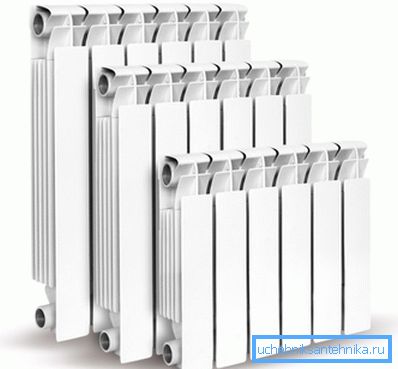
In our calculations, emphasis will be placed on bimetallic radiators, as the most demanded for autonomous heating systems, and among other things we will show you the video in this article.
Radiator power
Some features of heating
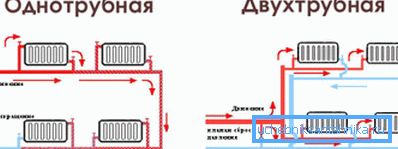
- When installing an autonomous heating instruction allows you to install both one-pipe and two-pipe circuit, but this will change the wiring diagram, and this can affect the power of the heaters, so let's find out what are both of these options.
- Let's start with a one-pipe system and here we see that the coolant moves through a thick pipe, from which thinner tubes flow, through which water under pressure enters the heater and returns. The price of such a device is less, because less water has to be heated, but there is a serious problem - the heat transfer medium gets colder and colder with each battery, therefore, in such cases it is recommended to manage with three or four radiators and nothing more, since they are the order of separation lose their power.
- The two-pipe system is completely different. - here, of course, you will have to heat much more water, but it, entering the radiators through the supply pipe, does not lose its temperature, as the cooled coolant is discharged into the return pipe. On such circuits, calculations of the power of different types of radiators will be the most accurate.
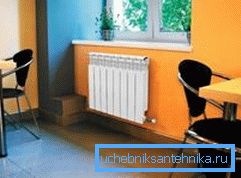
Note. In order to create the most constant microclimate in the room, there should not be a leak of warm air - this will also help to calculate the necessary heater power most accurately. So, radiators should be installed under the window, as in the photo above - hot air flows will rise up and create a “curtain” from the penetration of cold air emanating from the glass.
How many radiators are needed per room
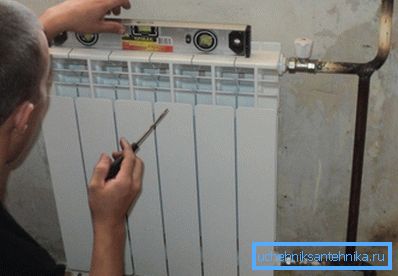
| The brand | marking | Distance between axes | Parameters W / W / H (mm) | Maximum working pressure (bar) | Thermal power section (W) | Section volume (l) | Mass (kg) | Max. ? C | Guarantee period | Manufacturer |
| Global | STYLE 350 | 350 | 425/80/80 | 35 | 125 | 0.16 | 1.56 | 110 | ten | Italy |
| STYLE 500 | 500 | 575/80/80 | 35 | 168 | 0.2 | 1.97 | 110 | ten | Italy | |
| STYLE PLUS 350 | 350 | 425/80/95 | 35 | 140 | 0.17 | 1.5 | 110 | ten | Italy | |
| STYLE PLUS 500 | 500 | 575/80/95 | 35 | 185 | 0.19 | 1.94 | 110 | ten | Italy | |
| Tenrad | TENRAD 350 | 350 | 400/80/77 | 24 | 120 | 0.22 | 1.22 | 120 | ten | Germany |
| TENRAD 500 | 500 | 550/80/77 | 24 | 161 | 0.15 | 1.45 | 120 | ten | Germany | |
| Altermo | ALTERMO LRB | 500 | 575/82/80 | 18 | 169 | 0.15 | 2.5 | 130 | five | Ukraine |
| ALTERMO RIO | 500 | 570/82/60 | 18 | 166 | 0.15 | 2.0 | 130 | five | Ukraine | |
| Grandini | GRANDINI 350 | 350 | 430/80/82 | sixteen | 130 | 0.26 | 1.55 | 120 | five | China |
| GRANDINI 500 | 500 | 530/80/80 | sixteen | 167 | 0.38 | 1.85 | 120 | five | China |
Power table of bimetallic radiators depending on the brand
Note. It should be noted that the metal from which the radiator is made has absolutely no significance when calculating the power of heating devices for a particular room. The fact is that the manufacturer always indicates in the accompanying documents the rated power of one section or the entire device, if it is a panel.
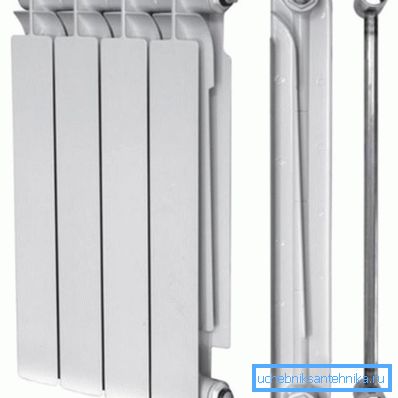
Now let's try to calculate the power of heating devices over the area of the room, and for example we will use a room with a perimeter of 4.556.5 m using the formula S * 100 / P, but here we should immediately say that these calculations are valid if the ceiling height does not exceed 2.7 m.
So, the S (area) of the room will be 4.5 * 6.5 = 29.25 m2, and for the power of section 1 of the bimetallic radiator (P) we take the GLOBAL STYLE 500 185 W, and the figure 100 is the number of watts per m2 for Moscow and the Moscow region.
Since the room we have is large enough and we will need to know the number of sections (K), it means that K number of sections = S * 100 / P = 29.25 * 100/185 = 15.81 or 16 sections is one large or two medium radiator.
Now let's calculate the required number of sections of the same manufacturer and with the same capacity for a room with the same area, but with ceilings that are more than 2.7m high and for a unit of account you can take a height of 3m.
Therefore, we first need to calculate the value of V - the cubic capacity of the room, this is V = 4.5 * 6.5 * 3 = 88.5 m3. For the same Moscow and the Moscow region, one cubic meter of space needs to produce 41 W of thermal energy.
Hence, the total power that is needed for the room will be Ptotal = V * 41 = 88.5 * 41 = 3628.5 watts. So, if the power of one section of a bimetallic radiator GLOBAL STYLE 500 is 185 W, then 3628.5 / 185 = 19.6 or 20 sections - these are, of course, already two radiators, since one will be too cumbersome.
But these calculations are valid only if the building has adequate insulation and there are no drafts in the room.
Conclusion
You can find out what the norms of heat consumption in your region are per square meter and per cubic meter, and then substitute these values in the above formulas. But just as you can take advantage of the standards given in this case - they are suitable for almost all regions of the Russian Federation.